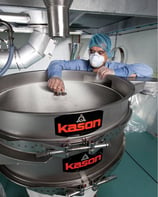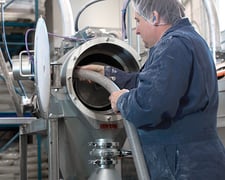Pristine and safe equipment is essential when choosing industrial processing equipment for the food  industry or other industries where consumer safety is a top concern. When humans or animals are going to consume the final product, you want to make sure that the processing machines are not subject to contamination of any type. For that reason, it’s important to look for the proper certifications.
industry or other industries where consumer safety is a top concern. When humans or animals are going to consume the final product, you want to make sure that the processing machines are not subject to contamination of any type. For that reason, it’s important to look for the proper certifications.
In the food industry, the top certification standard is 3-A Authorization. Some vendors will say they are compliant without having the authorization certificate—don’t fall for any piece of equipment that isn’t actually authorized. In the long run, skipping certification requirements will end up being an unnecessary cost – and potential liability – risk to your operation.
Who recognizes 3-A Certification and Standards?
The 3-A Authorization is recognized by the FDA and the USDA as a compliance certification that passes their standards and meets the ANSI requirements for equipment. 3-A standards incorporate assertions that the vendor complies with strict standards for hygiene and safety. In other words, if the equipment has 3-A Authorization when your facility is inspected by the local or regional authority, the 3-A symbol saves time and trouble. With this authorization, the inspector immediately knows that piece of equipment is good to go for any food or consumable application.
What’s involved in 3-A?
The reason you may pay a bit more for a 3-A Authorized piece of equipment is that there’s a material difference between a well-manufactured food processor and something that is “almost” good enough for certification. The 3-A Authorization is only provided by the 3-A Sanitary Standards Organization. It involves having a third party inspect the equipment for its safety and hygiene. The certification is only for US-manufactured equipment because it is based on standards required in the United States for consumer safety.
The process itself takes time and money, but that’s not the core of what 3-A Authorization is about. At the heart of the process is the manufacturing standards of the equipment itself.
The 3-A Authorization process involves different criteria depending on the type of equipment. For screeners and sorters, for example, the requirements are different than for something like a cooler or fluid bed dryer. The 3-A organization sends a third-party inspector who is specifically qualified for the particular type of equipment in question. While there may be a standard checklist involved, the in-person inspection is necessary because every potential safety or hygiene issue must be checked and certified.
Some areas are a must. For example, every 3-A Authorization will ensure that only authorized materials are used. We’ve seen cases where customers purchased equipment that was supposedly stainless steel but began to rust after a few years. When they checked, lo and behold, there were no certificates available from the vendor. While it was similar to a certified piece of equipment, in fact, it did not have the 3-A certification stamp.
One of the main focuses of the 3-A Authorization is making sure that the equipment is hygienic, which in simple words means it is easy to clean and easy to inspect. Easy cleaning can include safety features such as ergonomic and counter-weighted doors and easy-to-reach surfaces for cleaning. From a safety perspective, those are important for your staff. From a cost perspective, every tiny feature like that will save time when it comes to cleaning and inspecting the equipment. In other words, these special features aren’t just a convenience—they really do lead to cost savings in the long run. Fast and easy cleaning means you can run batches faster and that you spend less staff time on the cleaning process.
Other sanitary equalities include the cleanability of the equipment. Under this category, you’ll find features such as welded fittings and the polish of the surface, which should generally be at least 120 grit for food applications. Similarly, any intricate parts such as nozzles and screens should be easily removable for cleaning, and the mechanisms for fixing those parts in place need to be easy to clean and leave no crannies for residue. For Clean In Place (CIP) and Rinse In Place (RIP), you’ll find features such as the slant of all surfaces so that water always runs off without pooling in any location in the machine. In addition, all valves, gaskets, seals and other equipment need to be manufactured with food-grade materials.
Furthermore, getting authorization requires compliance with a variety of administrative and traceability standards. Materials used in the construction of machines must be appropriately sourced.
During a 3-A certification inspection, all of these qualities and more are investigated. You can easily see why this saves you time, as well as that of any food inspector. Each one of these areas can be a pitfall when it comes to the food safety and sanitation of your machine.
Your Bottom Line
Let’s face it: the food industry is competitive and it’s important to keep any eye on your profitability.  Purchasing a 3-A Authorized piece of equipment will probably cost you a bit more up front. What about in the long-term?
Purchasing a 3-A Authorized piece of equipment will probably cost you a bit more up front. What about in the long-term?
The biggest benefit you’ll get is not part of the equipment’s bill of sale, but it’s no less critical to calculate: the cost of recalls, lawsuits and publicity problems that won’t happen because your products are not contaminated by the equipment. How much is that worth to you? The average food recall cost is more than $10,000,000 in damages, not accounting for the loss of reputation and bad publicity. Last year there were more than 300 food recalls reported in the United States.
Other benefits are found in the operational costs of the machine. A 3-A Authorized machine will have a number of features, discussed in the previous section, that make it easier and faster to clean. When you’re processing any type of consumable, you’ll be cleaning the machine fairly regularly. If it’s dairy or other perishable food, you may be washing the machine several times per day. Every wasted minute adds up as far as downtime and staff time for the cleaning process.
Finally, a well-manufactured machine will last longer. A longer lifetime obviously means that you have saved costs in the long term, so you want to go with the highest quality tooling possible.
Conclusions: 3-A Authorization
When you add up all the potential risks and costs, it’s going to save time, money and trouble to choose equipment that is fully certified all along your production line. 3-A Authorization is the highest standard in the US. Be cautious and make sure that every vendor provides you the original certificates so you can have the peace of mind that your processing equipment meets the standards.

